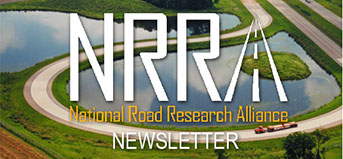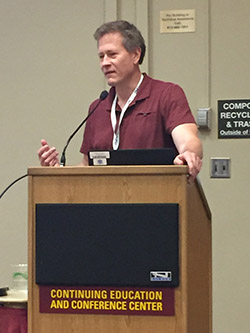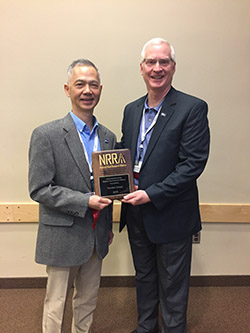NRRA Newsletter: May 2018

NRRA


Glenn Engstrom, Director
It was great to see all the NRRA members at the Workshop last week! I especially enjoyed the team reports and the testimonials from the states and associate members. We had about 30 speakers representing agencies, industry, consultants and academia, over the two days, and they put in a lot of work to make the Workshop a success. My thanks to all of them for giving us their insights on how to improve the performance of our highway system. Working together our alliance will accomplish great things over the next few years. I am already looking forward to next year! Have a great summer.
 |
 |
| John Donahue, MoDOT, talks about the research advantages of MnROAD | New Associate George Chang of the Transtec Group is welcomed by Glenn |
Editor's Note: Save the date for next year's workshop, May 22-23, 2019. For copies of the powerpoint decks used by our speakers, and recordings of the presentations, please visit our Workshop Page.
In the newsletter last spring (2017) we reported on a tool being developed by a team led by NRRA-member Jo Sias Daniel at the University of New Hampshire. The tool was a decision matrix that would help pavement engineers evaluate how soon a flooded road could be reopened once the floodwaters recede from the pavement surface. The tool is done and has gone through a year of beta testing and is almost ready to be released.
The tool itself is finalized, the user manual is done and the final report is written. FHWA is reviewing these materials for official publication prior to making the tool and report available on their website. Just to remind you, this is a spreadsheet program that takes a wide variety of factors into account once a road is flooded. It then helps the engineers on site decided when to open the road. It takes an engineering approach—not a political approach—to reopening the road:
The tool, says Daniel, asks “what’s the optimal decision in terms of balancing additional damage that would happen when the pavement is loaded in its weakened state, versus keeping it closed and incurring user delays because of the detours?” The tool also considers the value of additional information that may be obtained through testing such as FWD or GPR and provides recommendations on when that testing should be conducted.
The research team used data from Hurricane Katrina as well as flooding incidents in Iowa, Nevada, California and Mexico in the development of the tool. The agencies helping with the beta testing included the New Hampshire DOT, the Maine DOT, the Minnesota DOT and the FHWA.
The results of the tests? The tool works. Daniel says the research team learned a few things about making the user interface a bit friendlier. They also learned the tool needed to be able to switch between metric measurements and the English system. In the first iteration, the tool measured time in terms of days. The beta testers indicated that it would be better for the results to be broken down into 3-4 hour increments instead of days. During floods, facts change quickly and agencies often receive public and political pressure to open access as soon as possible.
Finally the team gave it the gut check: do the results coming out of the tool actually make sense?
While this tool is specific to flexible pavements, the final report for the project includes guidelines for the evaluation of both flexible and rigid pavements.
Daniel and her team plans to keep working on the tool, particularly adapting it and simplifying it for local road owners who have a smaller range of pavement types and also limited access to testing devices such as the FWD. Because the tool deals with water and pavement and saturation, it could also be adapted for spring load restrictions and even communities dealing with rising sea levels and the associated rise in groundwater levels.
We have a lot of new associate members to welcome this month, and that's great news for the alliance.
Welcome:
These new members will have pavement professionals on our Rigid, Flexible, Pavement Maintenance and Technology Transfer teams.
 |
 |
 |
 |
Professor Manik Barman is a researcher with deep roots in the world of concrete, but he also has a foot in the asphalt world. As such, he is somewhat unique in the world of academic research.
Barman oversees the pavement-related research at the University of Minnesota Duluth’s (UMD) Swenson College of Science and Engineering. By being ambidextrous at least in terms of pavement research, he can help his students with a wider array of research projects, and that gives his program more opportunities to find funding from both sides of the aisle.
His trajectory in the pavement world began at NRRA-member University of Pittsburgh’s Swanson School of Engineering, working under Julie Vandenbossche (who won the Gerald J. Rohrbach award at last year’s NRRA Pavement Conference). That’s where he did his Ph.D. work in concrete. After his doctoral program was finished, he ended up working at the University in Oklahoma where he did three years of research in asphalt. Finally, he ended up at UMD taking the position left by Eshan Dave when he went to another NRRA member organization, the University of New Hampshire.
When he got to UMD, he embarked on more concrete research, but he inherited one asphalt project from Eshan and wanted to see that through to the end. Again, a foot in each world—concrete and asphalt. So let’s go through the list.
Barman’s interest in fiber reinforced concrete cannot be stressed enough. In this project, he is working with MnDOT researchers Maria Masten and Tom Burnham, conducted a large-scale laboratory study to develop a specification for the use of fiber in concrete paving projects. When the spec is finished this year, it will answer the following questions:
This one, sponsored and developed by the NRRA Rigid Team, is less about laboratory testing and more about field performance analysis, says Barman. This long-term research effort installed fiber reinforced concrete test cells at MnROAD last summer. With all the sensors installed, these cells will generate a lot of data, and his team, working with the NRRA, hopes to find out how fiber:
This long-term research has already sparked discussion. Early on, a couple of test cells of very thin fiber-reinforced concrete started to crack. This spring the cracking was even more obvious. So now researchers such as Barman are asking if the fiber will hold the cracked pavement together, so the cracks won’t create total pavement failure. Moreover, can you still drive on cracked fiber-reinforced concrete without making it worse or having it affect the ride?
In this project, inherited from Professor Dave, UMD studied potholes and how to repair them. The research examined all the different kinds of potholes out there on the roads. Then it examined all the different repair methods available. Instead of recommending a one-size-fits-all approach, they developed a decision tree tool that matched the best patching method to the pothole in question. So if your pothole is a certain width, a certain depth, in the wheel path or between lanes, on a rural road with little traffic, this decision tree will show you which patching method will work best.
This project was sponsored by MnDOT and the results were very well received. A set of flash cards were developed for maintenance crews so they could find the right solutions for each pothole in a matter of minutes. A poster for the truck stations was also developed. The decision tool was so well received it even got media attention.
This research was sponsored by NRRA member the Local Road Research Board, and it asked Barman’s team to take an economic look at crack sealing practice. So his group took a comprehensive view of how we seal cracks, how much each solution costs and what is the quality of the fix. For example, the method of “rout and seal” is more expensive but is generally thought to be a better, more long-lasting fix. Therefore it’s more cost effective, right?
Barman’s research is going to challenge the conventional wisdom of crack sealing and really examine all the costs and benefits of our techniques. “Clean and seal” for example is a cheaper fix, but are there cases where it might also be more cost effective based on the road features, the age of the pavement, traffic levels and any future maintenance plans for the road? That’s what Barman and his students are going to find out.
The load transfer of concrete slabs on a road is important to the life of that road, but how do you measure it before the pavement construction. When Barman was studying under Vandenbossche back in Pittsburgh, they developed a simplified test method that could measure load transfer.
The test uses a 24-inch long beam of the concrete mixture in question and can test the mix without pouring a whole slab of it. This allows, explains Barman, researchers to test a lot of different mixes instead of just one or two. If you had to pour a whole slab, you would only be able to try one or two mixes because each slab costs about $25,000. Because the beams created for his test cost less than $1,000, he can test 50 different designs for the price of two concrete slabs. That, of course, allows researchers to test a wide variety of variables in the mix design. This test facility is available only at the University of Pittsburgh and UMD.
Barman and UMD are looking at more projects. And because his program isn’t limited to either concrete or asphalt, Barman can provide his students with a much more diverse range of research and, at the same time, can serve customers like the NRRA and MnDOT more completely.
June 19: Panel Discussion on Rejuvenators
We haven't ironed out all the details on this panel discussion, but check the Research Pays Off page in a week to see who our panel of experts will be.
Connection information for Webinar
Playlist of previous 2017-18 Research Pays Off webinars